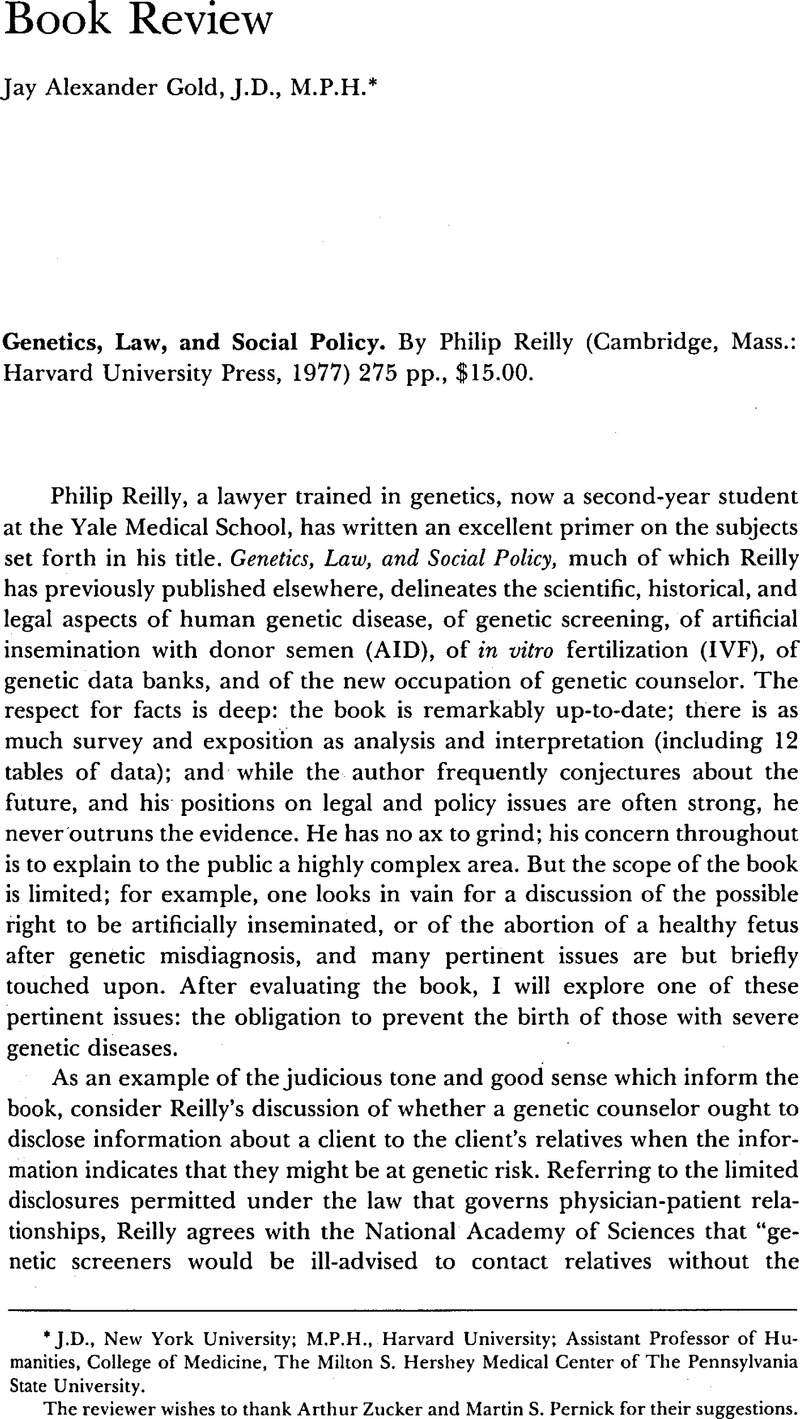No CrossRef data available.
Article contents
Genetics, Law, and Social Policy. By Philip Reilly (Cambridge, Mass.: Harvard University Press, 1977) 275 pp., $15.00.
Published online by Cambridge University Press: 06 May 2021
Abstract

- Type
- Book Review
- Information
- Copyright
- Copyright © American Society of Law, Medicine and Ethics and Boston University 1979
Footnotes
The reviewer wishes to thank Arthur Zucker and Martin S. Pernick for their suggestions.
References
1 P. Reilly, Genetics, Law, and Social Policy 168 (1978).
2 Id.
3 Id. at 169.
4 Reilly, supra note 1, at 67.
5 Health Research and Health Services Amendments, Pub. L. No. 94-278, 90 Stat. 407 (1976).
6 Such a role would amount to the recognition of a confidential relationship between patient and genetic counselor.
7 For an even more stringent approach, see Annas & Coyne, “Fitness” for Birth and Reproduction: Legal Implications of Genetic Screening, in Legal Medicine Annual 1976 at 273, 288 (C. Wecht ed. 1977).
8 Reilly, supra note 1, at 148.
9 Id. at 137.
10 At least one court has applied this reasoning to preconception injuries. See Renslow v. Mennonite Hosp., 67 Ill. 2d 348, 367 N.E.2d 1250 (1977).
11 A recent decision upholding a cause of action for “wrongful life” goes even further, speaking of “the fundamental right of a child to be born as a whole, functional human being.” Park v. Chessin, 60 App. Div. 2d 80, 88, 400 N.Y.S.2d 110, 114 (1977) (emphasis added), modified, No. 560 (N.Y. Ct. App. Dec. 27, 1978).
12 Capron, Informed Decisionmaking in Genetic Counseling: A Dissent to the “Wrongful Life” Debate, 48 Indiana L.J. 581, 598 n.60 (1973).
13 See Roe v. Wade, 410 U.S. 113 (1973). The Court held that the abortion decision is to be made by the attending physician, in consultation with the patient and without state regulation, until approximately the end of the first trimester. From then until viability, about the end of the second trimester, the state may regulate the abortion procedure in ways that are reasonably related to maternal health. From viability on, the state may regulate and even proscribe abortion except where the abortion is necessary to preserve the life or health of the mother.
14 “[N]or shall any State deprive any person of life, liberty, or property, without due process of law … .” U.S. Const. Amend. XIV (emphasis added).
15 See Clouser, “The Sanctity of Life”: An Analysis of a Concept, 78 Annals of Internal Medicine 119 (1973)Google Scholar.
16 See, e.g., Gleitman v. Cosgrove, 49 N.J. 22, 227 A.2d 689 (1967).
17 J. S. Mill, A System of Logic, Book II, Ch. III, Section 4 (8th ed. 1872).
18 See Roe v. Wade, 410 U.S. 113 (1973).
19 See Gustafson, Mongolism, Parental Desires and the Right to Life, 16 Perspectives in Biology and Medicine 529 (1973)Google Scholar.
20 Reilly states that if it were possible to collect fetal cells from circulating maternal blood rather than from amniotic fluid, compulsory fetal chromosome studies would be legally unobjectionable. By this logic, one might ask whether, if a method of abortion were developed— e.g., by oral or intravenous administration—that would significantly reduce the physical invasion, compulsion might be justifiable where a mother refused to agree to the abortion of a fetus with Tay-Sachs disease.
21 Curran, Public Health and the Law: Genetic Counseling and Wrongful Life, 68 Am. J. Pub. Health 501, 502 (1978)Google Scholar.
22 Reilly, supra note 1, a t 146.
23 Duff & Campbell, Moral and Ethical Dilemmas in the Special Care Nursery, 289 New England J. Med. 890 (1973)Google Scholar. That article reports many instances of infanticide at a typical teaching hospital.
24 On the other hand, “[extraordinary treatment, particularly when futile, does not appear to be a legal duty.” A. Holder, Legal Issues in Pediatric and Adolescent Medicine 123 (1977).




